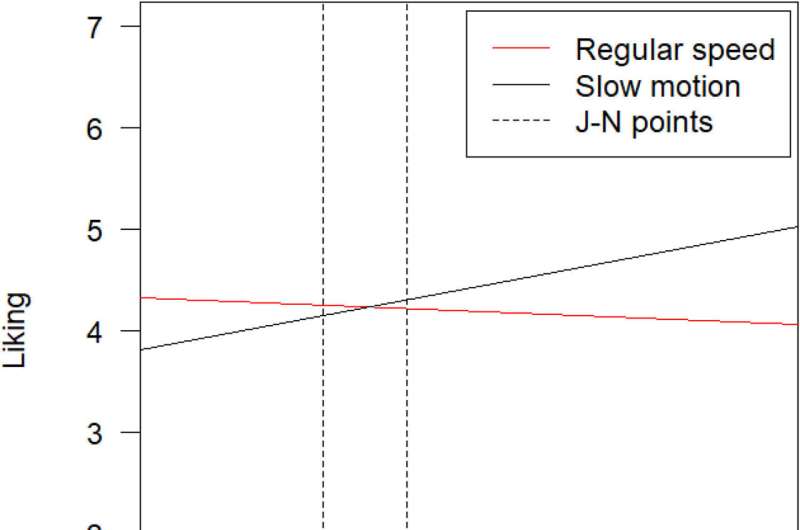Slow motion in videos increases number of likes and promotes brand preference, finds study
Slow motion is a popular style tactic for short videos on social media. Marketing researcher Anika Stuppy of Tilburg University shows that slow motion increases the number of likes and views of videos and stimulates brands’ preference, choice and willingness to pay. There are conditions to its use, however. The research helps marketers use slow motion more effectively.
The article, “The Art of Slowness: Slow Motion Enhances Consumer Evaluations by Increasing Processing Fluency,” has been published in the Journal of Marketing Research.
Although slow motion is used in many videos, there was little scientific evidence on how this technique affects a positive viewing experience. Previous research suggests that just the opposite is true. Radio broadcasts, for example, are enjoyed more when they are played faster.
Viewing pleasure is enhanced by slow motion
In the research, subjects were shown GIFs in a slow-motion version, and in a normal-speed version. It turned out that slow-motion GIFs were found to be much more enjoyable than the normal fast GIFs. This effect occurred because slow motion is easier to process, which feels pleasing to viewers.
Interestingly, this theory can also explain people’s viewing behavior on an online GIF-sharing platform. In a dataset that scanned several hundred GIFs from a website, the researchers saw that slow-motion GIFs were viewed more often, received more ratings and were generally rated more positively than regular fast GIFs.
Complex motion is a prerequisite
There are conditions to using slow motion, however. Stuppy states, “We see that slow-motion is especially a great technique when movements are slowed down that are extremely complex and difficult to observe at normal speed. Think, for example, of a TikTok video of a dance performance.”
Videographers themselves can also make a movement complex, and therefore interesting, for example, by zooming in on subtle movements. “For example, a slow-motion footage of a chef cutting a steak. This might be boring, but a close-up of the knife slicing through the meat in slow motion is aesthetically pleasing again,” says Stuppy.

Slow motion is not always appropriate
Slow motion is not recommended in some cases. Do not use slow motion in a video of a very simple movement, such as a simple dance. Such movements are more boring to watch in slow motion, according to the researcher. The research also shows that when slow motion is used for content that is unpleasant, it can make the viewing experience more unpleasant. For example, consider a video of a car accident or a bloody boxing match. In this case, slow motion reveals details that make the experience more unpleasant for the viewer.
Finally, the research shows that slow motion creates feelings of safety and familiarity. Therefore, it is not an appropriate technique is when you want to excite the viewer or show a product as “adventurous” or “exciting.” In that case, the researchers recommend fast-motion techniques.
More information:
Anika Stuppy et al, The Art of Slowness: Slow Motion Enhances Consumer Evaluations by Increasing Processing Fluency, Journal of Marketing Research (2023). DOI: 10.1177/00222437231179187
Citation:
Slow motion in videos increases number of likes and promotes brand preference, finds study (2023, December 13)
retrieved 13 December 2023
from https://phys.org/news/2023-12-motion-videos-brand.html
This document is subject to copyright. Apart from any fair dealing for the purpose of private study or research, no
part may be reproduced without the written permission. The content is provided for information purposes only.

Slow motion is a popular style tactic for short videos on social media. Marketing researcher Anika Stuppy of Tilburg University shows that slow motion increases the number of likes and views of videos and stimulates brands’ preference, choice and willingness to pay. There are conditions to its use, however. The research helps marketers use slow motion more effectively.
The article, “The Art of Slowness: Slow Motion Enhances Consumer Evaluations by Increasing Processing Fluency,” has been published in the Journal of Marketing Research.
Although slow motion is used in many videos, there was little scientific evidence on how this technique affects a positive viewing experience. Previous research suggests that just the opposite is true. Radio broadcasts, for example, are enjoyed more when they are played faster.
Viewing pleasure is enhanced by slow motion
In the research, subjects were shown GIFs in a slow-motion version, and in a normal-speed version. It turned out that slow-motion GIFs were found to be much more enjoyable than the normal fast GIFs. This effect occurred because slow motion is easier to process, which feels pleasing to viewers.
Interestingly, this theory can also explain people’s viewing behavior on an online GIF-sharing platform. In a dataset that scanned several hundred GIFs from a website, the researchers saw that slow-motion GIFs were viewed more often, received more ratings and were generally rated more positively than regular fast GIFs.
Complex motion is a prerequisite
There are conditions to using slow motion, however. Stuppy states, “We see that slow-motion is especially a great technique when movements are slowed down that are extremely complex and difficult to observe at normal speed. Think, for example, of a TikTok video of a dance performance.”
Videographers themselves can also make a movement complex, and therefore interesting, for example, by zooming in on subtle movements. “For example, a slow-motion footage of a chef cutting a steak. This might be boring, but a close-up of the knife slicing through the meat in slow motion is aesthetically pleasing again,” says Stuppy.

Slow motion is not always appropriate
Slow motion is not recommended in some cases. Do not use slow motion in a video of a very simple movement, such as a simple dance. Such movements are more boring to watch in slow motion, according to the researcher. The research also shows that when slow motion is used for content that is unpleasant, it can make the viewing experience more unpleasant. For example, consider a video of a car accident or a bloody boxing match. In this case, slow motion reveals details that make the experience more unpleasant for the viewer.
Finally, the research shows that slow motion creates feelings of safety and familiarity. Therefore, it is not an appropriate technique is when you want to excite the viewer or show a product as “adventurous” or “exciting.” In that case, the researchers recommend fast-motion techniques.
More information:
Anika Stuppy et al, The Art of Slowness: Slow Motion Enhances Consumer Evaluations by Increasing Processing Fluency, Journal of Marketing Research (2023). DOI: 10.1177/00222437231179187
Citation:
Slow motion in videos increases number of likes and promotes brand preference, finds study (2023, December 13)
retrieved 13 December 2023
from https://phys.org/news/2023-12-motion-videos-brand.html
This document is subject to copyright. Apart from any fair dealing for the purpose of private study or research, no
part may be reproduced without the written permission. The content is provided for information purposes only.
